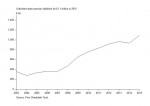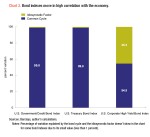Economy
Growth slows in key areas.
The decline in our Leaders index shows that economic weakness has spread over the past several months. This effectively tugged down continuing gains in the core domestic economy (including consumer spending, housing, and business investment). Braking those gains were declines in exports and commodity-related industries. As weakness spreads to some core growth components, it can drag down all the rest.
Over the final three quarters of 2015, real gross domestic product, or GDP adjusted for inflation, slowed from a 3.9 percent annualized rate in the second quarter to 2 percent in the third to just 1.4 percent in the fourth. During that period, investment in the residential sector contributed a relatively steady average of 0.3 percentage point to overall growth. However, the contribution from real personal consumption expenditures, or PCE, fell each quarter, providing 2.4 percentage points to growth in the second quarter, 2 percentage points in the third and 1.7 percentage points in the fourth. Nonresidential fixed investment performed even worse, contributing just 0.53 percentage point in the second quarter, 0.33 percentage point in the third, and subtracting 0.27 percentage point in the fourth (Chart 2).
The slowing expansion and declining contribution to growth among these core components is significant, especially in light of the declines in our Leaders index. We have noted for some time that pockets of weakness, notably in energy, mining, and manufacturing, were likely to be offset by gains in consumer spending, housing construction, and other areas of business investment. Continued weakening in these core areas would significantly increase the risk of a recession in the next six to 12 months.
Economic Outlook
Persistent inconsistent economic performance continues to be reflected in our Business-Cycle Conditions model. The drop in our Leaders index to 38 shows fewer than half of the indicators in the gauge were trending higher, down from 50 in the previous month. This suggests that a note of caution is appropriate. However, because this is the first monthly reading below 50 in about nine years and given the possibility of future revisions in the underlying data, it is too early to say that a recession is near.
The last time the Leaders index dropped into cautionary territory came in January 2007, when it fell to 44 from 50 in December 2006. With a reading decisively below 50, the risk rises that the current economic expansion may peak in the next six to 12 months, although one month of data is insufficient for us to assert that a recession is on the horizon.
Among the indicators in the Leaders index, just three were trending higher: real new orders for consumer goods, the average workweek in manufacturing, and the Treasury yield spread. Among the remaining indicators, six were headed lower and three were stable, or neutral.
The percentage of expanding coincident indicators held steady at 75 in February. Among the Coinciders, four were trending higher, one was headed lower, and one was neutral. The proportion of lagging indicators expanding was unchanged at 83 percent (Chart 3). Among the Laggers, five were trending higher, while one was trending lower.
Click for interactive Indicators at a Glance (on mobile device turn to landscape)
Next/Previous Section:
1.Overview
2. Economy
3. Inflation
4. Policy
5. Investing
6. Pulling It All Together/Appendix



